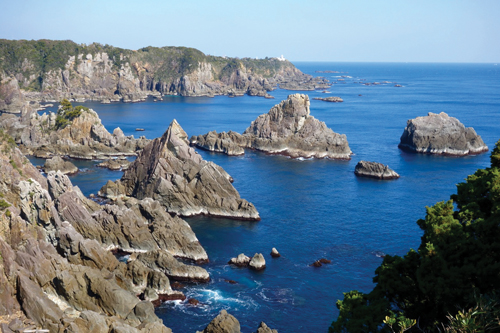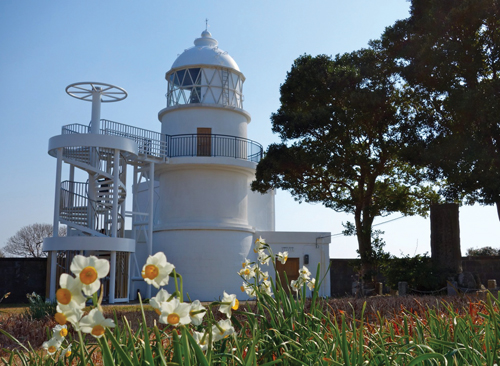Kii Oshima & Kushimoto 紀伊大島•串本

by Daniel Simmons
|
While scarfing down grilled meatballs at the venerable Tarihi Sultanahmet Koftecisi eatery in Istabul last summer, I struck up a conversation with a Turkish banker sitting beside me. We exchanged the usual pleasantries, and when he discovered that I lived in Japan, he smacked his lips with appreciation and told me that Japan was a great country. I agreed, but I asked him curiously why he thought so. The man then told me a remarkable story. In July 1889, the Turkish frigate Ertrugul, under the command of Captain Osman Ali Bey, departed Constantinople on a goodwill voyage to Japan to pay respects to the Meiji Emperor. Upon their arrival a year later, the officers and crew were received by the emperor and his retinue, with whom they exchanged gifts, medals, and pledges of friendship. In mid-September, its mission having been accomplished, the Ertrugul set sail back to Turkey. But disaster soon struck: typhoon-force winds and waves battered the boat mercilessly and collapsed the middenmast. The frigate’s crew battled to save their crippled vessel and steered for refuge at Kobe, but the Ertrugul was overwhelmed by bad weather and wrecked on the rocks of the southern Kii peninsula (in modern-day Wakayama). Of the 600-plus sailors and officers, all but 69 perished, including the ship’s commander. The survivors were rescued by the people of Kii-Oshima, who despite their poverty did their best to feed and clothe the bereaved and beleaguered sailors. Eventually the survivors were transported safely home via Japanese corvettes, rearriving in Constantinople in 1891. Since that time, the man in the kofte restaurant told me, there has been a great and lasting friendship between the Turkish and Japanese nations. I was eager to see this spot, which had spawned such tragedy and international goodwill, for myself. Today a memorial and a small but charming Turkish museum commemorate the events of 1890 at the site of the shipwreck, on a lonely but lovely stretch of saw-toothed coastline called Kashinozaki on Kii-Oshima. The museum (entry fee ¥250, signage in Japanese and Turkish only) and the Turkish souvenir shops across the road make for a startling but welcome international vibe in this remote corner of Japan. Who would have thought one could buy Turkish ice cream in a place like this?? The rocks and reefs that proved to be the undoing of the Ertrugul now attract their share of modern-day sightseers: a postcard-pretty lighthouse stands watch over the cape, scuba divers take advantage of the relatively warm waters and corals along the coast, and the gorgeous Umikongo rock formations stand tall against the pounding breakers just 1.5km southwest of the Turkish museum. The Umikongo observation point is near a hideous and frankly pitiful second international museum dedicated to “U.S.-Japan Friendship.” This museum attempts to honor the 1791 visit of the American tradeship “Lady Washington” to these shores; it contains glass-encased photocopies of old maps and ship charters, as well as a desultory and unlabeled collection of Native American paraphernalia. This may safely be skipped. Not to be skipped is another set of beautiful, unearthly rock formations called Hashigui-iwa, just up the shoreline northeast of Kushimoto train station. According to legend, these rocks are the makings of a never-completed bridge constructed by the great monk Kobo Daishi to connect Kushimoto and Kii-Oshima. Unfortunately his plans were foiled by a crafty local sea monster named Amanojaku. Even half-finished, however, this “bridge” is still a lovely sight, especially at sunrise and sunset. While you’re in Kushimoto, be sure to sample the fresh local seafood. And after a long day’s walk around the area, consider a refreshing soak at the Sango-no-yu hot spring facility, just a short stroll from the train station. |
去年の夏、僕はイスタンブルにいた。ある日現地のトルコ料理の老舗 “Tarihi Sultanahmet Koftecisi”で僕はミートボールを貪りながら、たまたま隣に座っていたトルコ人に話し掛けた。彼は銀行家だった。初めは軽く冗談を交わしていたが、私が日本に住んでいることを知ると彼はとても感慨深そうな表情で日本はとても素晴らしい国ですよね、と言った。僕もその通りだと思う、と言ったが、彼が日本を高く評価する理由が知りたかった。すると彼はこんな話をしてくれたのである。 1889年7月のある日、トルコの軍艦エルトゥールル号が司令官オスマン・パシャの指揮の下、イスタンブルを出港、はるか日本の明治天皇に親書を手渡す旅に出た。 当時トルコの新聞で大島村民による救助活動や日本政府の尽力が報じられ、当時のトルコ人は遠い日本に対して好印象を抱いたと言われている。これがその後の両国間の友好関係に繋がり、その関係は今日に至るまで続いている。 この話を聞いた僕はその所縁の地を訪れてみたいと思った。現在、紀伊大島の樫野埼灯台そばにはエルトゥールル号殉難将士慰霊碑およびトルコ記念館が建てられており当時を偲ぶことができる。トルコ記念館(入館料250円)と、道路を挟んだところにある土産物店はこの日本の片隅で両国の友好のシンボル的存在となっている。 大惨事の舞台となった岩礁地帯も今では観光地となっていて、美しい灯台が岬を見守るように建ち、付近の暖かい海流や美しいサンゴ礁のおかげでスキューバダイビングの人気スポットでもある。トルコ記念館の南西1.5キロあたりの海岸線は断崖下の海面から切り立つ巨岩が連なり、海金剛と呼ばれる景勝地となっている。海金剛を楽しむベストポイントは日米修交記念館近くにある。日米修交記念館は1791年にアメリカ商船レディ・ワシントン号がこの地に来航し、日本初の黒船来航地となったことを記念して建てられたものである。同館には当時の様子を解説したジオラマや写真、レディ・ワシントン号の模型が展示されている他、アメリカ先住民の生活用品なども展示されているが、ここは正直言ってわざわざ訪れるほど見応えのある記念館ではない。 一方、串本駅から北東方向の海岸にある奇岩群、橋杭岩はわざわざ訪れる価値がある場所だ。弘法大師が串本から紀伊大島まで橋を架けようとして途中で諦め、橋の杭のみが残った、という伝説が残っている。弘法大師が橋の建設を途中で諦めたのは悪鬼神である天邪鬼の巧妙な策略にはまったためだとされる。しかし完成半ばの“橋”はなかなか見応えのある光景を作り出していて、また橋杭岩を通して見る朝日や夕日はとても美しいと評判だ。 串本町に来たなら地元で獲れた新鮮な魚介類を外すわけにはいかない。歩き回って疲れたら串本駅からすぐのところにある「串本温泉浴場サンゴの湯」に浸かって疲れを癒すのもいい。 |









